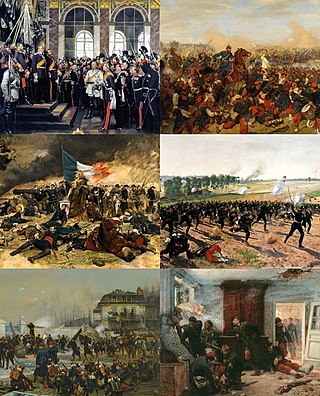
The Franco-Prussian War or Franco-German War, often referred to in France as the War of 1870, was a conflict between the Second French Empire and the North German Confederation led by the Kingdom of Prussia. Lasting from 19 July 1870 to 28 January 1871, the conflict was caused primarily by France's determination to reassert its dominant position in continental Europe, which appeared in question following the decisive Prussian victory over Austria in 1866. According to some historians, Prussian chancellor Otto von Bismarck deliberately provoked the French into declaring war on Prussia in order to induce four independent southern German states—Baden, Württemberg, Bavaria and Hesse-Darmstadt—to join the North German Confederation; other historians contend that Bismarck exploited the circumstances as they unfolded. All agree that Bismarck recognized the potential for new German alliances, given the situation as a whole.
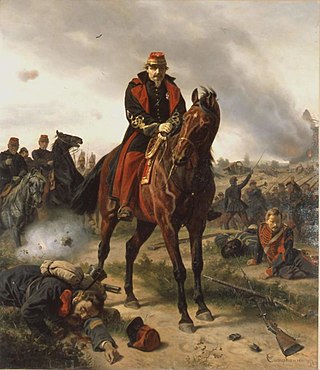
The Battle of Sedan was fought during the Franco-Prussian War from 1 to 2 September 1870. Resulting in the capture of Emperor Napoleon III and over a hundred thousand troops, it effectively decided the war in favour of Prussia and its allies, though fighting continued under a new French government.

The Battle of Saint-Quentin of 1557 was a decisive engagement of the Italian War of 1551–1559 between the Kingdom of France and the Spanish Empire, at Saint-Quentin in Picardy. A Habsburg Spanish force under Duke Emmanuel Philibert of Savoy defeated a French army under the command of Louis Gonzaga, Duke of Nevers, and Anne de Montmorency, Duke of Montmorency.

The siege of Metz was a battle fought during the Franco-Prussian War from August 19 to October 27, 1870 and ended in a decisive allied German victory.

The siege of Paris took place from 19 September 1870 to 28 January 1871 and ended in the capture of the city by forces of the various states of the North German Confederation, led by the Kingdom of Prussia. The siege was the culmination of the Franco-Prussian War, which saw the Second French Empire attempt to reassert its dominance over continental Europe by declaring war on the North German Confederation. The Prussian-dominated North German Confederation had recently emerged victorious in the Austro-Prussian War of 1866, which led to the questioning of France's status as the dominant power of continental Europe. With a declaration of war by the French parliament on 16 July 1870, Imperial France soon faced a series of defeats at German hands over the following months, leading to the Battle of Sedan, which, on 2 September 1870, saw a decisive defeat of French forces and the capture of the French emperor, Napoleon III.

The Battle of Le Mans was a German victory during the Franco-Prussian War that ended French resistance in western France.
The Battle of Chevilly was fought during the siege of Paris. The battle was the second French sortie from Paris against the German armies. On 30 September 1870 General Joseph Vinoy attacked the Prussian VI Corps at Chevilly and was easily repulsed.

The Battle of Villiers, also called the Battle of Champigny, was the largest of the French sorties from besieged Paris during the Franco-Prussian War.
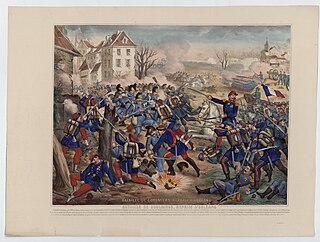
The Battle of Coulmiers was fought on 9 November 1870 between French and Bavarian forces during the Franco-Prussian War, ending in French victory.

The Battle of Bapaume took place during the Franco-Prussian War, brought about by French attempts to relieve the besieged city of Péronne, Somme. The battle was fought on 3 January 1871 near the town of Bapaume.
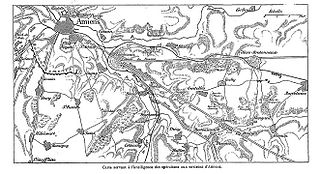
The Battle of Amiens, also known as the Battle of Villers-Bretonneux, was fought on 27 November 1870 between French and Prussian forces during the Franco-Prussian War (1870–1871). It ended in a Prussian victory, forcing the French to retreat and allowing the Prussians to capture Amiens, France.
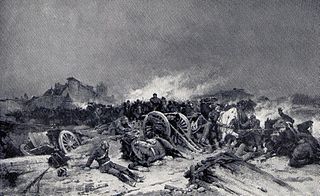
The Battle of Beaune-la-Rolande on 28 November 1870 took place during the Franco-Prussian War, which was won by Prussia. In an attempt to relieve the Siege of Paris, French General Crouzat's XX Corps launched an attack against three Prussian brigades resting in Beaune-la-Rolande. These brigades were from the Prussian X Corps which was detailed to guard the flanks and rear of the force besieging Paris and provide early warning of any French counter-attacks. The French committed a force of 60,000 men, largely conscripts of the Garde Mobile, and 140 guns against the Prussians' 9,000 men and 70 guns, mostly drawn from regular troops, although military historian Gaston Bodart estimated their strength at 40,000 men and 174 guns. Despite the superiority of numbers the French attack failed to take the village and was ultimately forced to retreat by Prussian reinforcements.

The Battle of Hallue was a battle of the Franco-Prussian War on 23 and 24 December 1870.
The 16th Division was a unit of the Prussian/German Army. It was formed as the 15th Division on September 5, 1818, in Koblenz from a troop brigade. It became the 16th Division on December 14, 1818, and moved its headquarters to Trier. The division was subordinated in peacetime to the VIII Army Corps. The division was disbanded in 1919 during the demobilization of the German Army after World War I. It was mainly recruited in the densely populated Prussian Rhine Province, mainly along the Rhine and the cities and towns along the Moselle River.
Events from the year 1871 in France.

The Battle of Villersexel took place on 9 January 1871 as part of the Franco-Prussian War. Elements of the French Armée de l'Est under General Bourbaki engaged August von Werder's German forces. It resulted in a French victory.
Events from the year 1871 in Germany.
The Battle of Châtillon, also known as the Battle of Châtillon-sous-Bagneux, was a skirmish in the Siege of Paris between France and North German Confederation in the Franco-Prussian War, took place on 13 October 1870. This is also considered the first battle in the history of the French Third Republic. In this fierce battle – occurred at Châtillon and Sceaux, Corps V of the Prussian army under the command of Lieutenant General Infantry Hugo von Kirchbach, along with the II Corps of the Kingdom of Bavaria by the Supreme Minister infantry Jakob von Hartmann which were the forces of the army Group 3 of Prussia by Prince Friedrich Wilhelm as General command., won a victory against an attack by the XIV Corps under General Renault - of the French army under General Auguste-Alexandre Ducrot. Although some soldiers under Ducrot fought well, the majority of his army became agitated. The French were forced to flee to Paris, losing the Châtillon Plateau - a very favorable defensive position overlooking the fortresses south of Paris - to the Germans. This was a disaster for the "justice" of the French army during the war, although the French reported that they suffered only minor losses.
The Battle of Buchy was fought during the Franco-Prussian War, on 4 December 1870, at Buchy, Seine-Maritime, France. During the battle, the VIII Corps of the Prussian Army, under the command of General of the Infantry August Karl von Goeben, suddenly attacked and defeated a French force under the command of General de Brigade Guillaume Briand. The French suffered heavy losses. After their victory at Buchy, German troops captured Rouen.

The siege of Peronne was a battle during the Franco-Prussian War, from December 26, 1870 until January 9, 1871, in Péronne, Somme of France. The German siege force, under the command of Lieutenant Generals August von Goeben and Albert von Barnekow, forced the French army at Péronne- which could not be rescued and had to surrender after more than a week under the bombardment of the Prussian army. With the victory, the armies of Albert von Barnekow captured a defending force of thousands of French soldiers in Peronne, and obtained a large number of cannons and war materials to the Prussians hands. In general, the advantage of the artillery of the Prussians as well as the dynamism of German officers is credited with leading to German victories in the sieges of French fortresses, and the success at the Siege of Péronne solidified German control over the river Somme.














